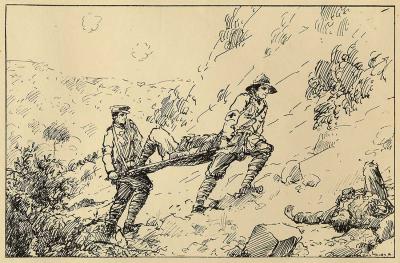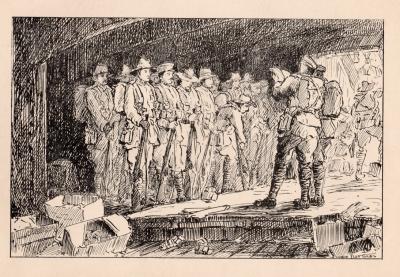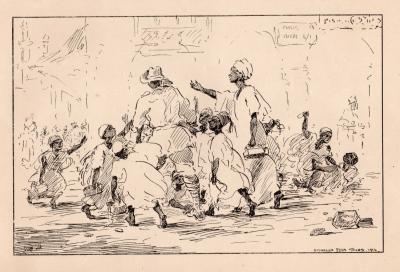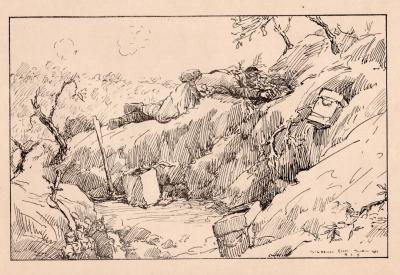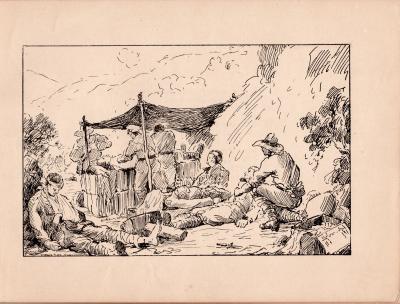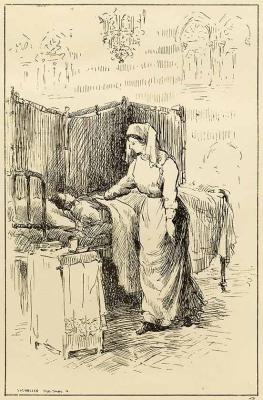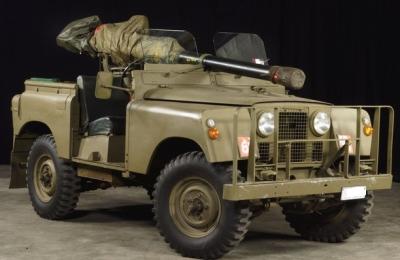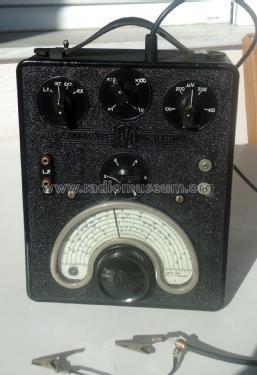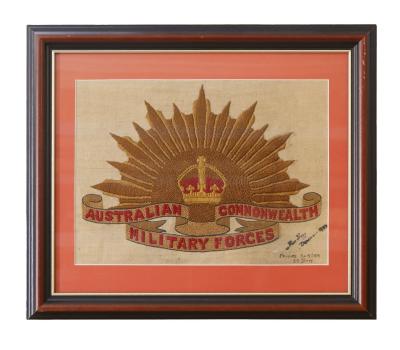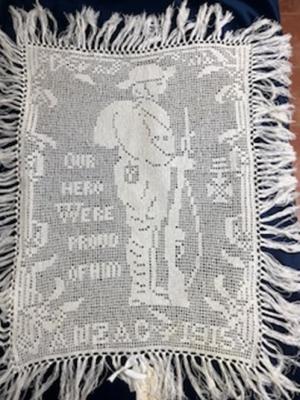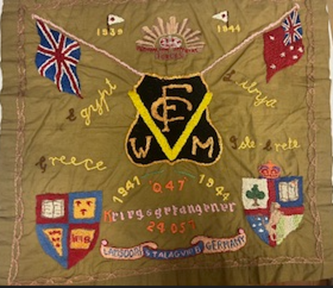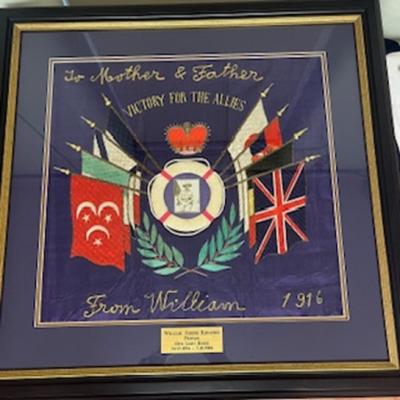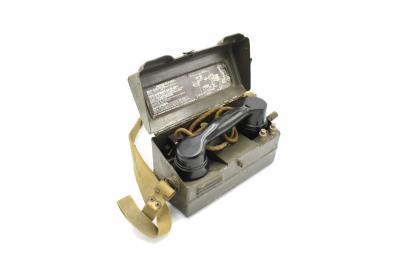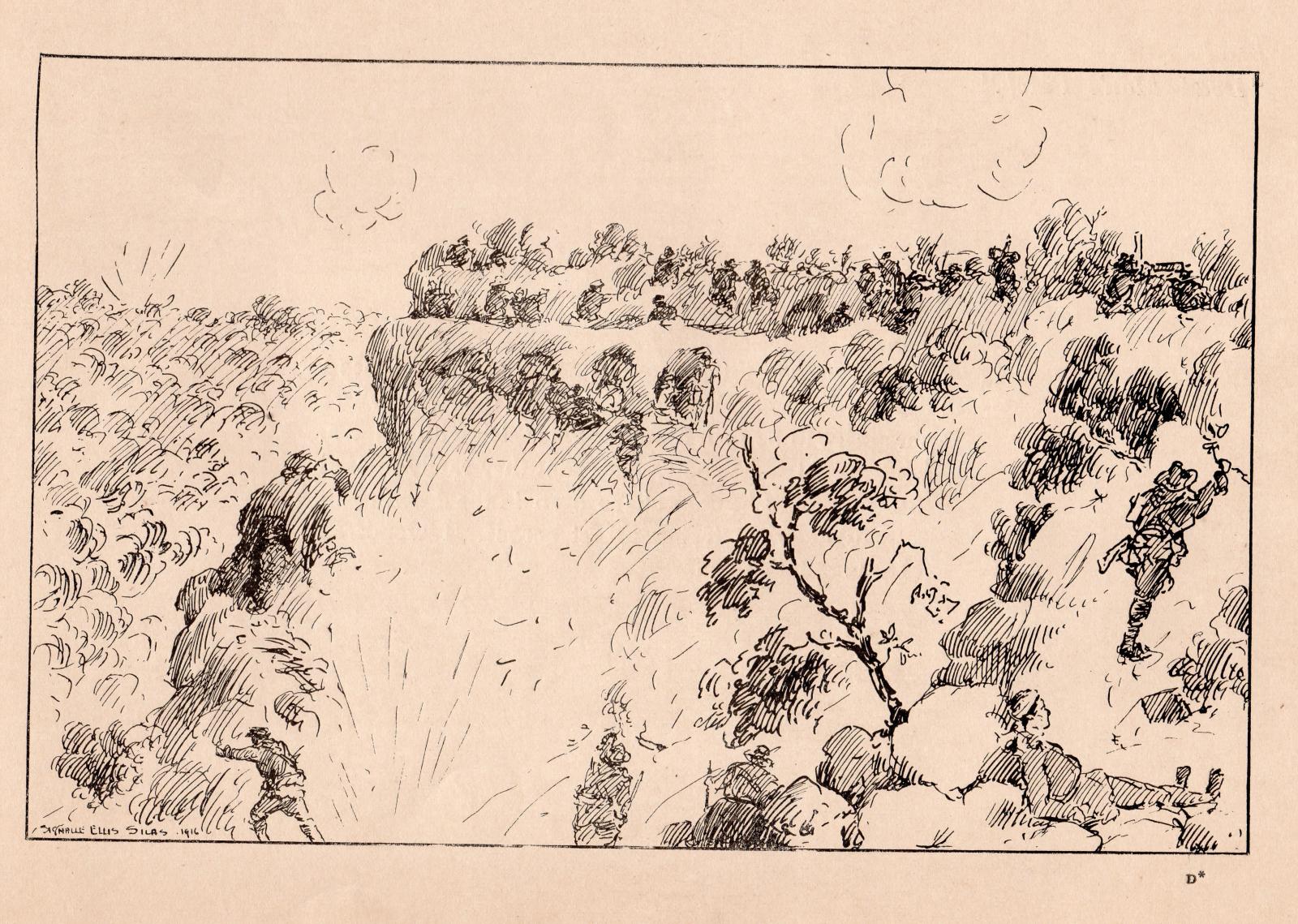World War 1, South-West Asia, Türkiye, Gallipoli, SILAS, "Crusading at Anzac"
Extract from "Crusading at Anzac", "Pope's Hill". Sketch by Ellis Silas
Ellis Luciano Silas (13 July 1885 - 2 May 1972) was a British artist and draughtsman who served as an ANZAC during World War 1. He was .born in London, Silas' grandfather was the Anglo-Dutch composer Edouard Silas and his father, Louis Silas was an artist. Silas studied art from his father and was also a student of the artist Walter Sickert. In 1907, aged 23, Silas moved to Australia where he continued to develop as a painter.He painted in Sydney and Melbourne before settling in Perth.
Silas enlisted in the Australian Imperial Force (AIF) in October 1914.. Silas was never confident that he would make a good soldier even though he had served in the Royal Naval Volunteer Reserve and had some experience of military life. Silas embarked with the 16th Infantry Battalion for Egypt in December 1914. Throughout early 1915, Silas continued his training as a signaller outside Cairo, Egypt.
On the evening of 25 April 1915, the battalion was waiting on the deck of a transport to go ashore on Gallipoli The Battle of the Landing on Gallipoli in which the 16th Battalion took part lasted from 25 April to 3 May 1915. Silas told some of the battalion's story after the Gallipoli Campaign in a book called Crusading at Anzac AD 1915. Silas' book is based on extracts from the diary and sketchbook he kept during his time at Anzac. His words and images provide a dramatic insight into the dangers, hardships and loss that accompanied the Anzacs as they tried to establish a foothold on the Gallipoli peninsula.
Silas landed on Gallipoli in the evening of 25 April with the 16th Battalion. In the first weeks on Gallipoli, 16 Battalion was reduced to two companies suffering heavy casualties at Pope’s Hill and Quinn’s Post. By 17 May, Silas had become seriously ill and was taken by hospital ship back to Egypt. From Egypt, he was transferred to England and in August 1916, was discharged from the AIF as being permanently unfit for active service.
His sketches from the front were viewed by King George and Queen Mary in May 1916. His book Crusading at Anzac was published in 1916 with forewords by Sir Ian Hamilton and William Birdwood.
Signaller Ellis Silas was the only artist to paint and sketch actual battle scenes showing Australian soldiers in action at Gallipoli. He was commissioned in 1919 by the Australian War Records Section to paint images of Gallipoli at the initiative of C. E. W. Bean who wanted ex-servicemen to paint from their experiences.
Details
Details
Named after Colonel Harold Pope of the 16th Battalion, Pope's Hill was a razor-backed ridge lying at the centre of a fork at the head of Monash Valley, in the heights above ANZAC Cove. It was occupied by Australian troops on 25 April 1915 and remained a key post on the ANZAC frontline until the end of the campaign. Pope's Hill commanded a good field of fire over the Turkish lines opposing the crucial position of Quinn's Post and thus was a favourite spot for Australian snipers and the site of several machine-guns and trench mortars.
This was the most advanced position, at that time, and quite the hottest corner in Anzac, Every few minutes, with sickening monotony, would sound the cry —“ Stretcher bearers!! ” Poor fellows, how magnificently they worked* This drawing gives an idea of the nature of the ground across which they had to carry the wounded; and when it rained, it was well-nigh impossible to obtain a foothold. The shells seen bursting are from our own ships. The hill on the left was stiff with snipers. The domelike dug-out, half-way down the edge of the hill, was the quarters of Major Mansbridge, All his signallers were put out of action by snipers, so I had to do the work of A and B Companies— signals and despatches—alone. I think the Turkish snipers were keenly interested in my movements, too much so for my liking. I like people to take an interest in me, but there are times when I wish they wouldn't. Anzac, April, 1915.
Signaler Ellis Silas was the only artist to paint and sketch actual battle scenes showing Australian soldiers in action at Gallipoli. He was commissioned in 1919 by the Australian War Records Section to paint images of Gallipoli at the initiative of C. E. W. Bean who wanted ex-servicemen to paint from their experiences. An exhibit featuring the life and art of Ellis Silas including "Crusading at Anzac" is currently on display in the Temporary Exhibition Gallery at the Army Museum of Western Australia.
Australian Army Museum of Western Australia
Australian Army Museum of Western Australia
More items like this
- World War 1, South-West Asia, Türkiye, Gallipoli, SILAS, "Crusading at Anzac"
- World War 1, South-West Asia, Türkiye, Gallipoli, SILAS, "Crusading at Anzac"
- World War 1, South-West Asia, Türkiye, Gallipoli, SILAS, "Crusading at Anzac"
- World War 1, Eastern Mediterranean, Egypt, SILAS, "Crusading at Anzac"
- World War 1, South-West Asia, Türkiye, Gallipoli, SILAS, "Crusading at Anzac"
- World War 1, South-West Asia, Türkiye, Gallipoli, SILAS, "Crusading at Anzac"
- World War 1, South-West Asia, Türkiye, Gallipoli, SILAS, "Crusading at Anzac"
Other items from Australian Army Museum of Western Australia
- World War 1, Eastern Mediterranean, Egypt, SILAS, "Crusading at Anzac"
- 106MM RECOILESS RIFLE (M40)
- Electonic Test Equipment - Wave Oscillator
- Telephone Technology - British Post Office SE50 Exchange Switch, 1950s
- World War 1, Framed Soldier Embroidery, Rising Sun Badge, 4046 HOGG, 32 Battalion AIF
- World War 1, Filet Crochet Commemorative Tablecloth, 5678 CALLAGHAN, 1915
- World War 2, Embroidered Handkerchief, WX3595 TILLOT, 2/7th Field Ambulance
- World War 1, Family Framed Embroidered Textile Souvenir, 1607 KINSTON, 10 Light Horse, 1916
- Vietnam - Scrim Sweat Rag, 55093 LAWLER, 4 Field Regiment,
- Manual Rural Telephone Exchange / Switchboard, 1930s
- World War 2, Field Telephone Set H Mk III
